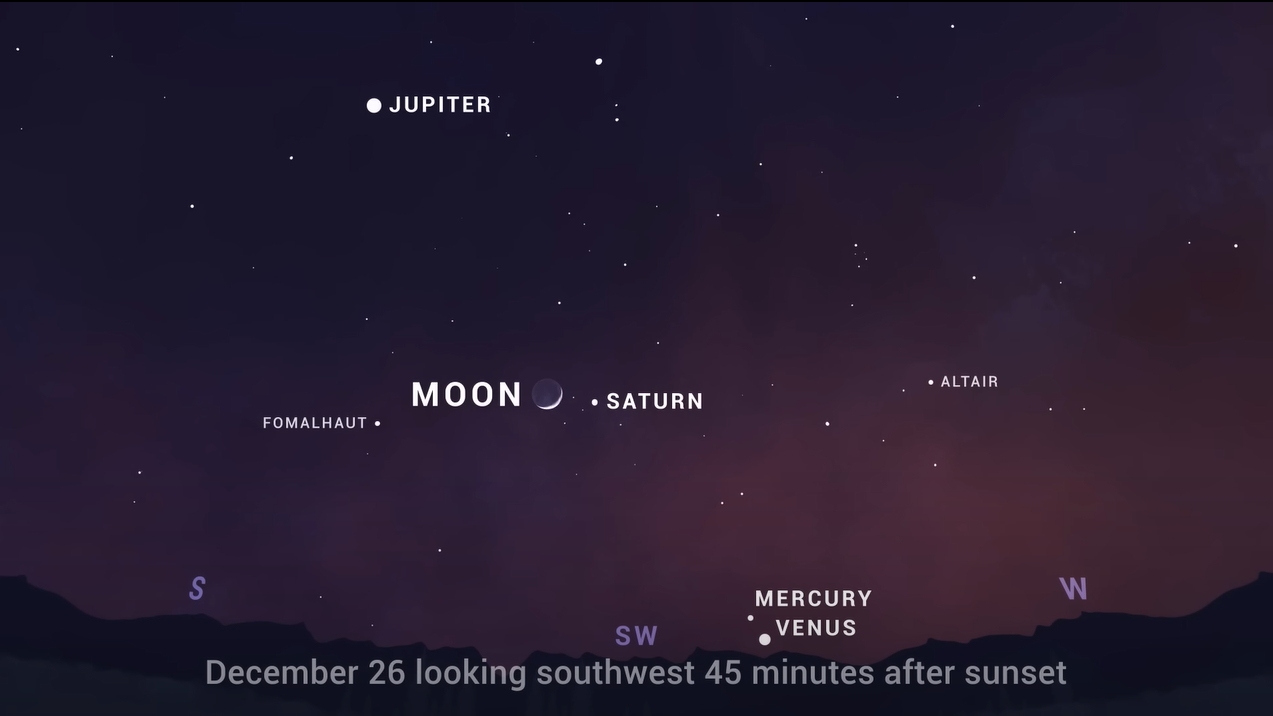See Saturn near the moon in a late Christmas gift in the night sky tonight (Dec. 26)
The second-largest planet in the solar system will be in conjunction with the moon for the last time in 2022 on Dec. 26.
The moon will visit Saturn for the last time of 2022 on Monday (Dec. 26) in a parting Christmas gift in a twilight conjunction that will disappear from view before night sets in.
Saturn and the moon will shine together southwestern sky, with the moon to the left of the ringed planet, which is the second largest planet in the solar system after its fellow gas giant Jupiter. The three-day old moon will appear 4 degrees south of Saturn (for veteran skywatchers, you'll find them at a right ascension of 21 hours, 37 minutes, 20 seconds in the night sky). Your closed fist held out at arm's length covers 10 degrees of the night sky.
The conjunction will become visible over New York City at around 4:53 p.m. EST (2152 GMT) as the sky darkens, appearing at 29 degrees above the horizon to the southwest, according to In the Sky.

Want to get a better look at the planets or the moon? We recommend the Celestron Astro Fi 102as the top pick in our best beginner's telescope guide. Don't forget a moon filter if you'll be looking towards our celestial companion.
The moon and Saturn will then sink towards the horizon before disappearing at around 8:20 p.m. EST (0120 GMT on Dec. 27) around 3 hours and 47 minutes after the sun sets.
During the conjunction, the moon will be at magnitude -10.8 with the minus prefix indicating a bright object in the sky over Earth, while Saturn will have a magnitude of 0.7. Both objects will be in the Capricornus constellation.
The conjunction will be visible with the naked eye or with a pair of binoculars, but despite their close approach, will still be too widely separated to see with a telescope.
If you're hoping to observe the next conjunction of Saturn and the moon, our guides for the best telescopes and best binoculars are a great place to start. If you're looking to snap photos of the night sky, check out our guide on how to photograph the moon, as well our best cameras for astrophotography and best lenses for astrophotography.
Breaking space news, the latest updates on rocket launches, skywatching events and more!
The sixth planet from the sun and 9 times wider than Earth, Saturn is one of five solar system planets bright enough to be seen with the naked eye. The others are our planet's close neighbors Mars and Venus, the closest planet to the sun, and the solar system's largest planet, the gas giant Jupiter.
Without the aid of a viewing instrument, Saturn appears as little more than a speck of light. Binoculars allow it to be resolved as a yellowy-brown blob, but the use of a telescope really highlights what is arguably the planet's most striking feature — the ring of Saturn.
According to NASA, Saturn's rings are believed to be composed of broken-up pieces of comets, asteroids, and even moons torn apart by the massive gas giant’s gravitational influence. The chunks of ice and rock in the rings are coated with dust and range from tiny grains to chunks as big as a house to even the odd mountain-sized lump.
The ring system of Saturn extends for an estimated 75,000 miles (282,000 kilometers) away from the gas giant but is still relatively thin having an estimated thickness of around just 30 feet (10 meters).
The ring system consists of several separate rings labeled alphabetically in the order they were first observed, with the primary brighter rings being A, B, and C. Rings D, E, F, and G are fainter and were discovered more recently. All these rings orbit Saturn at different speeds.
Skywatchers that are too wrapped up in Yuletide reveling or present wrapping to observe the conjunction between the moon and Saturn just two days before Christmas will have another chance on Jan. 23, when the two bodies share the same right ascension again for the first time in 2023.
Editor’s Note: If you snap the conjunction between Saturn and the Moon, and would like to share it with Space.com’s readers, send your photo(s), comments, and your name and location to spacephotos@space.com.
Follow us on Twitter @Spacedotcom or on Facebook.

Robert Lea is a science journalist in the U.K. whose articles have been published in Physics World, New Scientist, Astronomy Magazine, All About Space, Newsweek and ZME Science. He also writes about science communication for Elsevier and the European Journal of Physics. Rob holds a bachelor of science degree in physics and astronomy from the U.K.’s Open University. Follow him on Twitter @sciencef1rst.

